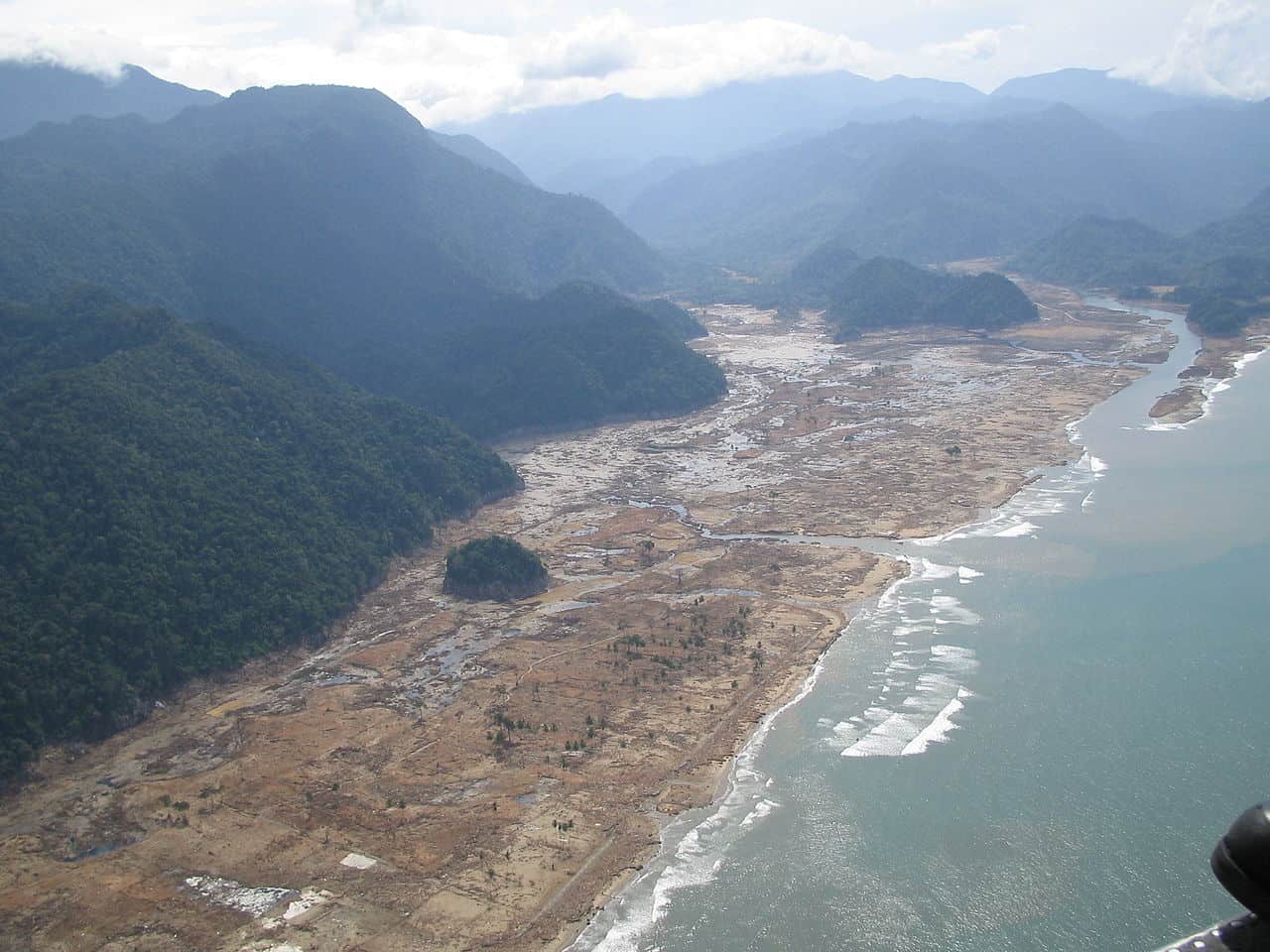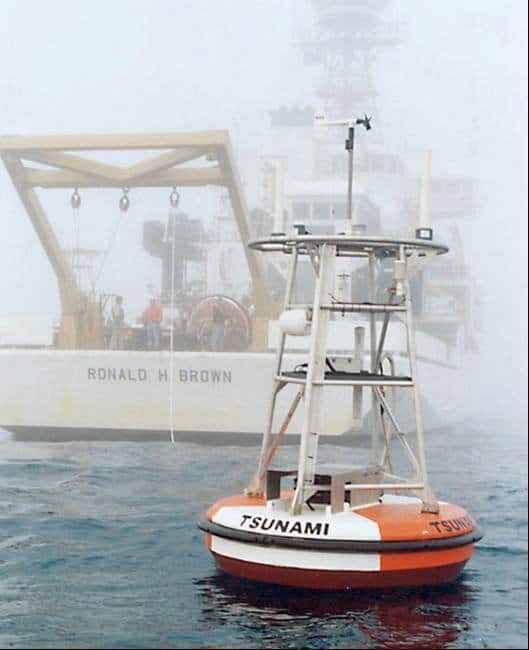
When there is a displacement of a significant volume of water, a tsunami occurs. It’s a series of massive and gigantic waves, usually caused by volcanic eruptions and earthquakes. This usually happens in an ocean or a large lake. Any and all lists of tsunami facts say that they are one of the most powerful and destructive natural forces in the world. And we agree!
Tsunamis can strike the shoreline and can last for hours. They come not just as one wave, but as multiple waves with strong currents! The water and energy that tsunamis contain can destroy buildings, houses, cars, power lines, and almost everything in their way. Tsunamis may also result in deaths that include drowning and traumatic injuries.
The beginning of a tsunami starts with a rumbling sound akin to a freight train or a Boeing 747 taking off. Then a wall of water appears, carrying with it such incredible force it can easily and instantly flatten an entire structure. So, what can you do when a tsunami hits? If you’re swept up in a turbulent current, the best thing you can do is cling to something that floats, like a tree trunk or a post. Also, re-enter structures only after they’ve been inspected for structural stability. Tsunami waters, like floodwaters, can weaken a structure’s foundations, causing floors to break and walls to fall. Long after the tsunami waters have receded, bodies, wrecked sewer lines, tainted freshwater supplies, and downed power lines pose the greatest health dangers.
Want to know more about tsunamis? Check out our list of fascinating tsunami facts below! Learn how to prevent them, how they came to be, their history as a whole, and other useful information. Who knows? What you know might just save your life!
- The wavelength of a tsunami ranges from 10 to 500 kilometers.
- A tsunami may travel at around 200 meters per second, or more than 700 kilometers per hour.
- Earthquakes with a 6.5 magnitude are less likely to make a tsunami.
- Tsunamis can make the sea rise to around 10 feet.
- Tsunamis are uncommon events but can occur about twice a year.
- Seismic sea wave is another term for a tsunami.
- Earthquakes and volcanic eruptions can cause a tsunami.
- A tsunami consists of a series of waves.
- Tsunami can be very destructive.
- Tsunamis are sometimes mistaken for storm surges.
- The wave period of a tsunami is also called “wave train.
- A tsunami’s wave period may vary from minutes to hours.
- Tsunamis sometimes appear as quickly rising tides.
- Tsunami just like tidal waves produce waves of water that move inland.
- Tsunamis are also known as killer waves.
- Tsunami is a Japanese word which means ‘harbor wave.’
- The first wave of a tsunami is usually not the strongest, the succeeding waves become stronger and bigger.
- Some zoologists believe that animals have the ability to sense waves from earthquakes or tsunami.
- An approaching tsunami produces a loud roaring sound, similar to the sound of a train or a jet aircraft.
- Some people believe that seeing a tsunami in a dream may mean insecurity, vulnerability, and a desire to be independent.
80% of tsunamis occur within the Pacific Ocean's "Ring of Fire."
Around 80% of tsunamis happen within the Pacific Ring of Fire. It is an area where active volcanoes and earthquakes frequently occur. The “Ring of Fire” includes areas like North America, South America, Kamchatka in Russia, and some islands in the western Pacific Ocean.
A mega-tsunami is a rare phenomenon.
A mega-tsunami is a tsunami with an initial wave height that is much higher than the usual tsunami. It is so great, it can reach up to several hundred meters in height.
A mega-tsunami occurred in Lituya Bay, Alaska.
One of the tallest and biggest tsunamis in history happened in Lituya Bay, Alaska in July 1958. A mega-tsunami measuring around 1,720 feet occurred, following an earthquake which happened only 13 miles away from the tsunami. Miraculously, the mega-tsunami killed only five people.
The 2004 Indian tsunami is one of the deadliest tsunamis.
An undersea earthquake with a magnitude of 9.1 hit the coast of Indonesian Island in Sumatra on December 26, 2004, at 7:59 a.m. Over the following hours, a tsunami erupted from the Indian Ocean. It destroyed coastal areas as far as East Africa. The waves reached a height of about 30 feet or 9 meters.

Approximately 225,000 people died in the 2004 Indian tsunami.
The 2004 Indian tsunami caused more than 250,000 deaths in Indonesia, Sri Lanka, India, Maldives, and Thailand. In Indonesia alone, officials reported around 200,000 deaths in Sumatra Aceh Province. The Maldives reported more than a hundred casualties and enormous economic damage.
Tsunamis often occur in Japan.
Japan lies along the northwest Pacific Ring of Fire, which is why it regularly experiences earthquakes and tsunamis. Throughout the recorded history of Japan, a total of 141 tsunamis have occurred and more than 130,00 have people have died.
The 2011 Tohoku Tsunami was one of the most destructive tsunamis in Japan.
On March 1, 2011, one of the strongest earthquakes hit the Oshika Peninsula of the Tōhoku region and lasted for approximately 6 minutes. The earthquake resulted in a tsunami that produced waves up to 40 meters or 132 feet high, and killed more than 15,500 people.
Furthermore, it also destroyed the country’s infrastructure like homes, roads, businesses, railways, and also resulted in the meltdown or severe overheating of three nuclear reactors at the Fukushima Daiichi Nuclear Power Plant.
Magnitudes 7.6 and 7.8 earthquakes may cause a destructive tsunami.
Earthquakes from magnitude 7.6 to 7.8 (especially near the epicenter) can create destructive tsunamis. Nevertheless, in this magnitude range, tsunamis’ capability of causing damage to far areas is very rare.
Tsunami and tidal waves are not the same.
Tsunami and tidal waves are two unrelated and different phenomena. The gravitational interaction between the moon, Earth, and sun can cause tidal waves. Meanwhile, earthquakes, underwater slide, and onshore landslides, or when a large volume of debris fall on the water may create a tsunami.
Sieberg-Ambraseys scale measured the intensity of tsunamis.
The German geophysicist, August Heinrich Sieberg developed a device called the Sieberg Scale in 1927. The device was a six-degree scale that can measure the strength of tsunamis based on the effects on humans, nature, buildings. Later in 1962, Nicholas Ambraseys, a Greek engineering seismologist, adapted the Sieberg Scale in the form of the Sieberg-Ambraseys scale.
A buoy is an instrument used to detect tsunamis.
The Bureau of Meteorology uses deep-ocean tsunami buoys to detect the existence of tsunami waves generated by underwater earthquakes. The buoy is a floating device, and has several purposes, One main purpose is to record and observe changes in sea level.

The 1755 Lisbon Tsunami killed around 90,000 people.
On November 1, 1775, at around 9:40 in the morning, an earthquake impacted Portugal, the Iberian Peninsula, and Northwest Africa. Approximately 40 minutes after the earthquake, a tsunami with a three-wave cycle, around 6 meters, high struck Lisbon, along with the towns of the west coast of Portugal, and killed approximately 90,000 people.
A tsunami's height grows as it nears the land.
In the ocean, the height of tsunami waves does not change. Accordingly, the tsunami’s speed lessens as it moves on shallower water, and it increases its height as the depth of the ocean decreases, as they travel inland or gets near the shore.
Hawaii has a greater risk of having tsunamis.
Due to the location of Hawaii in the middle of “The Ring of Fire,” it is vulnerable to earthquakes and tsunamis. Over the years, several damaging tsunamis hit Hawaii, and the earliest recorded tsunami happened around the 1980s.
A 50-foot-tall tsunami struck Hawaii in 1946.
On April 1, 1946, after a magnitude 8.1 earthquake struck near the Aleutian Islands, a tsunami 50 feet high surged onto the island of Hawaii. It was one of the most destructive tsunamis that hit Hawaii. It went as far as Alaska and California. It caused the deaths of 150 people and the destruction of homes, businesses, and roads.
The 1946 Hawaii Tsunami had a silver lining.
The tsunami that hit Hawaii in 1946 was a sort of wake-up call. The horror of the event urged the development of a tsunami warning system commonly used today. The calamity also raised awareness to Hawaii residents to practice more safety procedures during a tsunami like moving on higher ground on foot rather than fleeing in a car in the midst of a tsunami.
The US has two tsunami warning centers.
The United States has two tsunami warning centers operated by the the National Tsunami Center. These centers aim to help and protect life and property against the force of a tsunami. The staff from these warning centers monitor tsunamis and earthquakes, issues forecasts on tsunami impacts, releases tsunami messages, and facilitates public outreach. They also work with other partners to continuously improve their warning operations.
The Pacific Tsunami Warning Center is one of the warning centers in the US.
Founded in 1949, the Pacific Tsunami Warning Center is one of the warning centers in the United States. It is on Ford Island, Hawaii. PWTC is an international tsunami warning system that issues warnings and bulletins to the participating members and Hawaii’s local or regional warning system.
PTWC issues different types of bulletins.
PTWC issues different types of bulletins depending on seismic data. If there is a threat but no evidence yet of a tsunami, it’s a Tsunami Information Bulletin. It’s a Tsunami Watch if it has been determined that an earthquake may likely create a tsunami. Tsunami Advisory, if it has determined that an earthquake has created a tsunami and strong waves that are dangerous for those who live near the water. Lastly, a Tsunami Warning is released if the condition is serious enough to release an immediate concern to the different parts of the Pacific.
National Tsunami Warning Center is an international tsunami warning system.
The National Tsunami Warning Center is an international warning system, headquartered in Palmer, Alaska. It serves the coastal regions of Canada and the United States excluding Hawaii, the Gulf of Mexico, and the Caribbean. The NTWC monitors and analyzes earthquakes worldwide and issues warning to local officials.
Thucydides was one of the people to interpret the cause of the tsunami.
The Athenian historian and general, Thucydides, studied the cause of the 426 BC Malian Gulf Tsunami that destroyed the Gulfs of Malian and Euboean in Greece. He concluded that the earthquake must have been the cause of the tsunami. Thucydides was also the first known to explain the source of a tsunami as a natural disaster.
Palm trees can endure tsunami waves.
Palm trees are known to withstand tsunami waves. People often plant palm trees near the shore because of their strong and durable characteristics. They have adapted well to destructive storms, gusts, tsunami waves, and even hurricanes.

Tsunamis retain their energy.
Aside from traveling at high speeds, tsunamis can also travel at far distances with limited energy loss. Therefore, tsunamis can retain their energy. This energy will be sufficient to travel across the oceans.
Scientists believed that an asteroid caused a giant tsunami.
Some scientists believed that there is evidence of an asteroid-collision event 3.5 billion years ago that resulted in a giant tsunami. This mega tsunami covered the Earth several times and destroyed everything, except the mountains.
Local tsunamis pose the biggest threat.
Generally, warning systems identify the type of tsunami that may hit the land. One type of tsunami is the local tsunami. A local tsunami comes from a nearby source and has damaging effects only on coasts within 100 kilometers of the source. A local tsunami is normally triggered by an earthquake, although it can also be triggered by a landslide or a volcanic eruption’s pyroclastic flow. It poses the greatest threat to a nearby community because the source of the tsunami is close to the seashore. When this happens, there may not be enough time to release warnings and evacuate.
Distant tsunamis can also be very destructive.
A distant tsunami, also known as a distant-source tsunami, far-field tsunami, and teletsunami, may originate from far away from the shore, or more than 1,000 km away from the landfall. Distant tsunamis also cover larger areas than the usual tsunamis, and can also be very destructive. But unlike the local tsunami, there is enough time to issue warnings, respond to advisories, and evacuate.
Stay on higher ground during a tsunami.
During a tsunami, it is important not to go near the shore to watch the tsunami. Being near the shore makes it more difficult to escape from the tsunami. It best to stay on higher grounds and stay inside where you will be protected from water.
Many people have the misconception that they can surf on a tsunami.
Apart from the tsunami is too high and does not have a face, it also travels a lot faster than ordinary waves making it very dangerous to surf on it. Moreover, a tsunami can quickly throw you into anything such as buildings. After tossing you inland, it can pull you back to the ocean.
The "San Andreas" movie features a tsunami triggered by a magnitude 7.1 earthquake.
The 2015 American disaster film “San Andreas” highlighted a 7.1 earthquake that triggered a tsunami that struck San Francisco Bay in California. In the movie, a container ship caught up in the wave and destroyed the Golden Gate Bridge, and killed everyone on the bridge. The tsunami also destroyed the whole city and killed thousands more.
Experts believe that if the Canary Islands collapse, it may trigger a massive tsunami.
The Canary Islands lie at 100 kilometers of the coast of Africa. It is a group of 7 volcanic islands. The islands’ coastlines are massive and steep. For a long time, there is speculation that this may collapse and may result in a massive tsunami that may affect the coasts of Europe, the eastern seaboard of the US, and Antarctica.
Was this page helpful?
Our commitment to delivering trustworthy and engaging content is at the heart of what we do. Each fact on our site is contributed by real users like you, bringing a wealth of diverse insights and information. To ensure the highest standards of accuracy and reliability, our dedicated editors meticulously review each submission. This process guarantees that the facts we share are not only fascinating but also credible. Trust in our commitment to quality and authenticity as you explore and learn with us.
